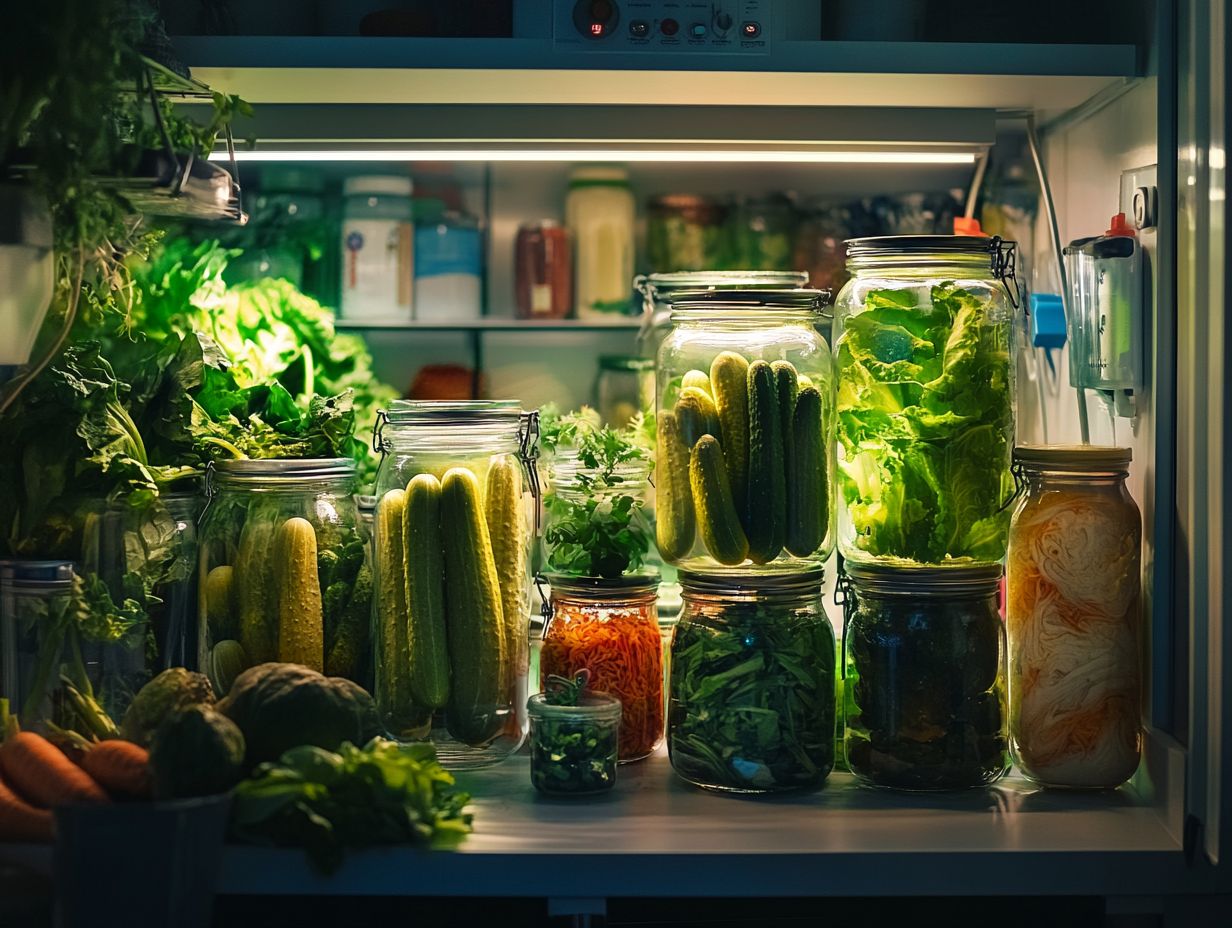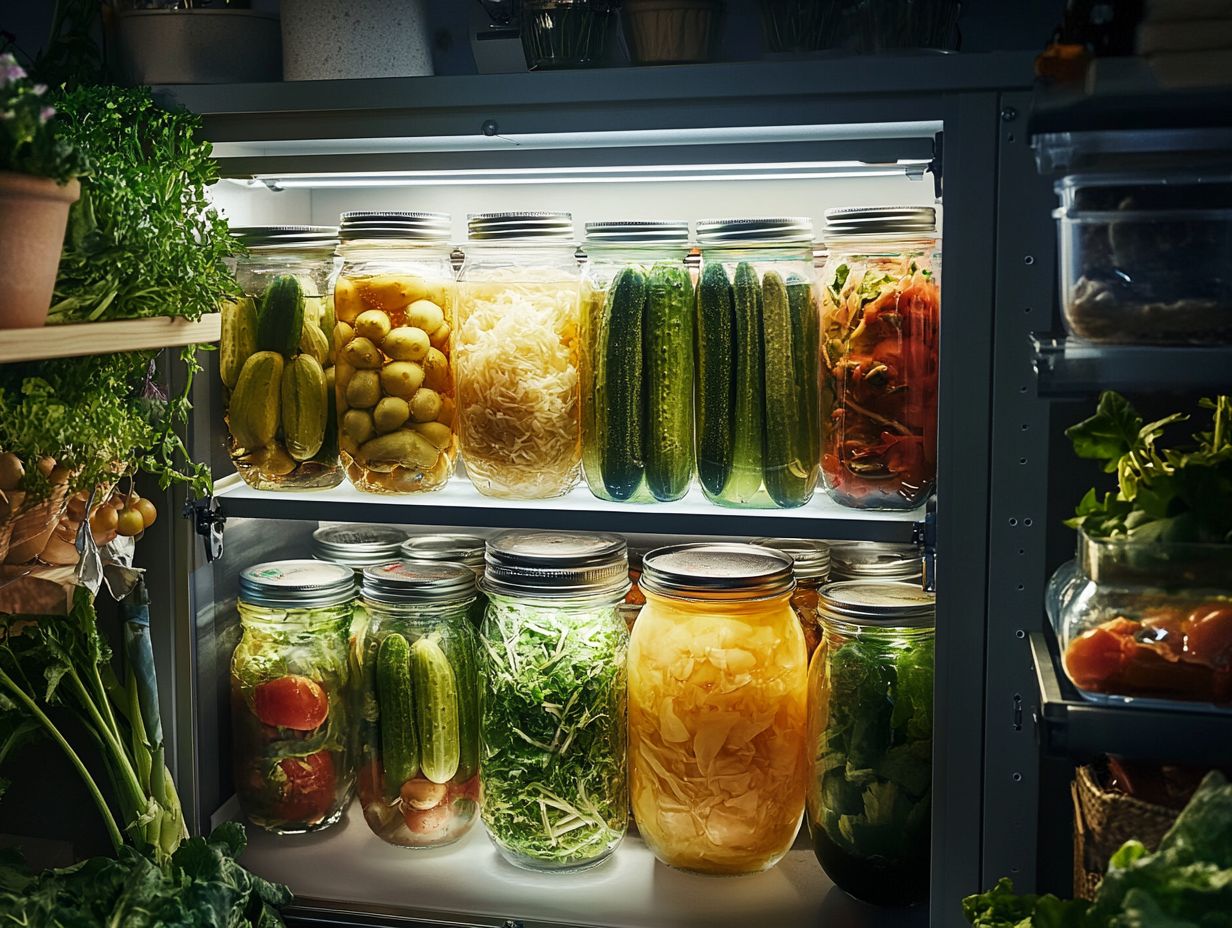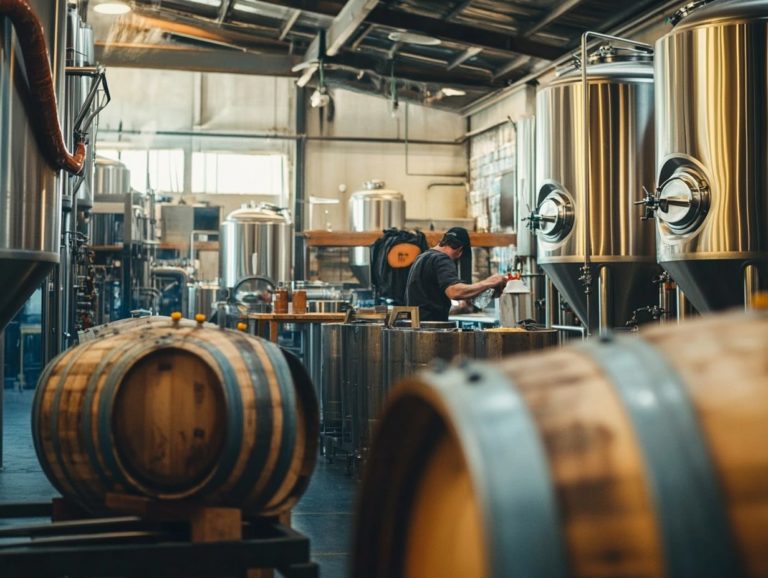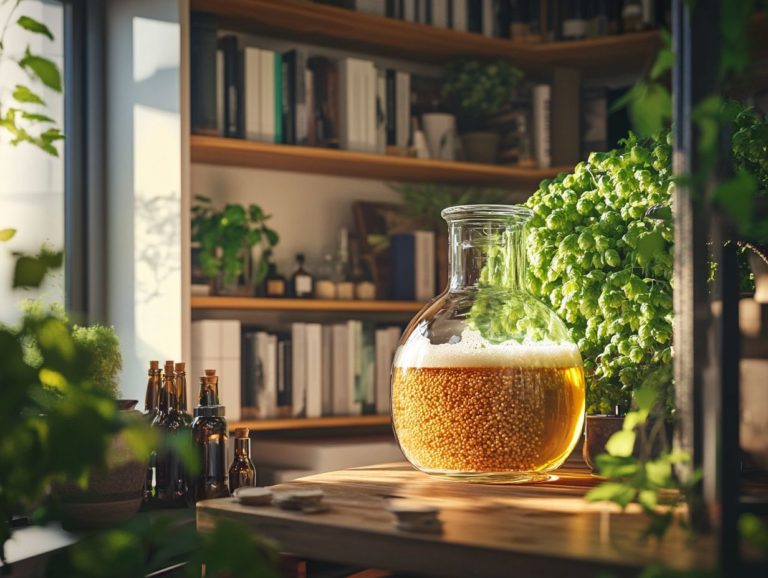The Benefits of Using Fermentation Chambers
A fermentation chamber is an indispensable asset for both homebrewers and professional brewers, offering a meticulously controlled environment for fermentation. By managing fermentation temperature and protecting your brew from external influences, these chambers can greatly improve the quality and consistency of your final product, helping you brew better beer.
This article delves into fermentation chambers, their significance, the ideal fermentation temperatures, the different types available, and a comprehensive step-by-step guide for setting one up. Prepare to transform your brewing experience!
Contents
- Key Takeaways:
- What is a Fermentation Chamber?
- Why is a Fermentation Chamber Important for Brewing?
- What are the Benefits of Using a Fermentation Chamber?
- What are the Different Types of Fermentation Chambers?
- 2. DIY Insulated Box
- 3. Commercial Fermentation Chambers
- How to Set Up and Use a Fermentation Chamber?
- 2. Installing a Temperature Controller
- 3. Adding Insulation and Sealing the Chamber
- 4. Monitoring and Adjusting Temperature
- Frequently Asked Questions
- What is a fermentation chamber and why is it beneficial to use one?
- What are the advantages of using a fermentation chamber for homemade beer or wine?
- Are there any benefits of using a fermentation chamber for sourdough bread making?
- Benefits of Using a Fermentation Chamber
Key Takeaways:

- Proper temperature control is crucial in fermentation, and a fermentation chamber allows for precise and consistent temperature regulation.
- Fermentation chambers protect the brewing process from external factors such as temperature fluctuations and contamination, ensuring proper temperature control and leading to a better end product.
- Using a fermentation chamber can enhance the flavor and aroma of your final product, making it a valuable tool for both homebrewers and commercial brewers.
What is a Fermentation Chamber?
A fermentation chamber is an essential asset for any homebrewer, offering precise control over fermentation temperature a vital element for crafting exceptional beer. By maintaining an optimal fermentation temperature profile, you ensure that the yeast operates at its best during the fermentation process.
This controlled environment mitigates the risks associated with temperature fluctuations, which can adversely affect brewing. A fermentation chamber becomes an invaluable tool for both novice and seasoned homebrewers, elevating your brewing experience significantly, especially regarding the alcohol fermentation process.
Why is a Fermentation Chamber Important for Brewing?
A fermentation chamber is essential for your brewing endeavors. It enables you to maintain precise temperature control an element that profoundly influences both the fermentation process and the quality of your final product.
By creating a stable environment, you allow the yeast to flourish during fermentation, resulting in consistently flavorful brews that elevate your craft.
Optimal Fermentation Temperatures for Different Yeast Strains
The ideal temperature for fermentation varies based on the yeast strain you re using. Generally, ales thrive between 65 F and 75 F, while lagers prefer a cooler range of 50 F to 60 F. Understanding these specific temperature requirements is essential for homebrewers aiming to craft sought-after flavor profiles while avoiding off-flavors.
Remember, yeast is a living organism, and its performance can be dramatically influenced by temperature. For example, ale yeast strains, which are top-fermenting, flourish in warmer conditions. This not only speeds up fermentation but also fosters the development of fruity esters that add complexity to your beer.
On the flip side, lager yeast, being bottom-fermenting, performs best in cooler environments, yielding cleaner flavors that highlight the malt or hop characteristics.
To ensure your brewing success, pay close attention to yeast pitching rates adding the right amount of yeast for your brew s volume and gravity is crucial. Keeping a stable fermentation temperature is vital, as fluctuations can stress your yeast and lead to unwelcome flavors like diacetyl or phenolic off-flavors.
Utilizing temperature control methods, whether through fermentation chambers or water baths, will help maintain the ideal environment for yeast health and elevate your brewing experience.
What are the Benefits of Using a Fermentation Chamber?
A fermentation chamber is vital for a homebrewer’s fermentation needs, ensuring a temperature-controlled area for optimal results.
Utilizing a fermentation chamber presents you with numerous advantages as a homebrewer. You’ll experience exceptional control over brewing temperatures, ensuring consistency throughout your fermentation processes.
These chambers shield your precious brews from external environmental factors, allowing for a more stable and optimal brewing environment. They also enhance the flavor and aroma of your final beer, elevating it to a level of quality that truly reflects your craftsmanship.
When considering fermentation chamber construction, it is important to focus on insulation and aluminum tape sealing to maintain the internal environment.
With all these benefits, investing in a fermentation chamber is a game-changer for crafting high-quality beers right in your own home.
1. Temperature Control
Temperature control serves as the foundation of successful fermentation. It enables you to create an environment that maintains a stable fermentation temperature absolutely essential for the health and activity of yeast.
By incorporating advanced cooling and heating elements into your brewing setup, you can sustain optimal conditions throughout the fermentation process. These systems minimize temperature fluctuations, critical for nurturing a vigorous fermentation environment.
For example, a well-designed cooling unit can swiftly lower the temperature during the crucial lag phase. Heating elements are ready to raise the temperature if it unexpectedly dips.
DIY fermentation chamber setups often include the use of insulation foam sheets and aluminum tape to create an efficient temperature-controlled area.
This level of precise regulation promotes healthy yeast growth and enhances the flavor profiles and clarity of your final beer product.
When you meticulously manage temperature, you can anticipate consistent fermentation outcomes that directly influence the overall quality and character of your beer, leading to brewing better beer.
2. Consistency in Fermentation

Achieving consistency in fermentation is essential for you as a homebrewer, as it directly impacts the reliability of your beer fermentation process and the overall quality of your brew.
It is imperative to consider the fermentation temperature needs specific to your type of brew.
By utilizing fermentation chambers, you can establish and maintain stable temperature ranges crucial for how yeast works. Yeast performs best within a specific temperature spectrum. When these temperatures fluctuate, you risk introducing unwanted flavors and aromas that can compromise your final product.
A consistent fermentation temperature profile ensures that the desired ester and phenol characteristics develop as intended, resulting in well-balanced and flavorful beers.
This level of control enhances your brewing process and creates a reliable environment that contributes to your overall success and satisfaction with your craft.
In conclusion, investing in a fermentation chamber not only improves your brewing outcomes but also enriches your experience as a homebrewer. Explore fermentation chambers today and elevate your brewing journey!
3. Protection from External Factors
Fermentation chambers offer you a sanctuary from external factors that can disrupt your fermentation process, such as temperature swings from the outside world or contamination from airborne particles.
Elements such as 2×4 lumber and OSB can be used in the construction of DIY fermentation chambers, ensuring they provide a stable environment.
The insulation and carefully designed features of these chambers create a stable environment that is ideal for fermentation.
Proper insulation acts as a formidable barrier, significantly reducing energy loss while maintaining a consistent internal temperature. This is vital for the activity of yeast and bacteria.
These insulated enclosures greatly reduce the risk of unwanted microbial growth by shielding your creations from potential contamination in the atmosphere.
This design helps preserve the quality of your fermented products, whether it s beer, wine, or kombucha, throughout the entire process. This intentional focus on design enhances flavor profiles and overall product reliability.
Building a fermentation chamber can be as simple as converting a mini fridge fermentation setup with proper insulation and a temperature controller.
4. Enhanced Flavor and Aroma
Employing a fermentation chamber can significantly elevate the flavor and aroma of your final beer. Precise control over fermentation temperatures enables yeast to produce delightful esters and phenols you desire. Techniques such as using a side-loading setup can also be beneficial.
By maintaining specific temperatures, especially between 60 F and 70 F for ales, you ll love how your yeast produces fruity esters like banana and pear, enriching your brew s sensory experience!
On the flip side, if fermentation occurs at higher temperatures around 75 F or above you risk the production of unwanted phenols, leading to off-flavors that might resemble clove or even carry a spicy note. For example, a Belgian-style witbier thrives on warmer fermentation, resulting in vibrant aromas of orange peel and coriander.
Conversely, when you lager at cooler temperatures, you can highlight cleaner, crisper profiles, allowing the malt and hop characteristics to shine. Grasping the intricate relationship between temperature and yeast behavior is essential for crafting unique and well-balanced beers that impress the palate.
What are the Different Types of Fermentation Chambers?
You have a variety of fermentation chamber options at your disposal as a homebrewer. From straightforward DIY fermentation chambers and insulated box setups to more advanced mini-fridge systems equipped with built-in temperature control features, the choices are abundant and tailored to suit your brewing needs. For example, utilizing items like aluminum tape and temperature controllers can vastly improve your setup.
1. Refrigerator or Freezer Conversions
Refrigerator and freezer conversions have become a favored tactic among homebrewers seeking to create effective fermentation chambers, all while employing a temperature controller to maintain those all-important, consistent fermentation temperatures. Communities like HomeBrewTalk and resources in places such as New Braunfels, Texas, can provide valuable insights into this process.
This approach allows you to harness the existing cooling capabilities of standard appliances, giving your brewing capabilities a significant boost.
To transform a fridge or freezer into a fermentation chamber, you’ll need to install essential components like a temperature controller that manages the appliance’s cooling functionality. Adding insulation materials can further enhance temperature retention, ensuring those fluctuations remain minimal.
The true beauty of this method lies in its ability to foster a stable environment for yeast activity. This stability ultimately leads to superior flavor profiles and improved fermentation efficiency across various beverages from beer to wine making it a go-to choice for both novice and seasoned brewers alike.
2. DIY Insulated Box
A DIY insulated box is your ticket to a cost-effective and customizable fermentation chamber, offering the flexibility to tailor size and features while ensuring effective insulation.
To kick off this essential brewing enhancement, gather your materials: rigid foam insulation boards, a sturdy wooden or metal frame, and a reliable temperature controller. Begin by measuring the dimensions that will comfortably accommodate your fermentation vessels. Cut the insulation to fit snugly within the frame, creating a tight seal that minimizes temperature fluctuations.
As you assemble the box, opt for an adhesive that bonds well with foam. Once constructed, make sure to seal all seams and edges with aluminum tape; this not only boosts insulation but also keeps unwanted outside air at bay. You might also want to consider adding a small fan for air circulation this can be a game-changer in maintaining a consistent temperature throughout the fermentation process.
3. Commercial Fermentation Chambers

Commercial fermentation chambers are carefully designed for brewing, boasting advanced features such as built-in temperature controllers and optimized insulation that ensure consistent temperature control throughout the brewing process.
They simplify your brewing experience, allowing you to immerse yourself in the creative joy of crafting your beers without the nagging worry of temperature fluctuations that could compromise an entire batch. With exact humidity controls and programmable fermentation schedules, these chambers can elevate the flavor profiles of your brews to impressive levels.
The initial investment in a commercially available chamber might seem higher, but the reliability and time savings often justify the cost. Although DIY options allow for some customization and can be more budget-friendly, they typically fall short in efficiency and user-friendliness. For many serious homebrewers, purpose-built fermentation chambers emerge as the clear choice, combining performance with ease of use.
How to Set Up and Use a Fermentation Chamber?
Establishing and utilizing a fermentation chamber requires careful attention to several essential steps:
- Choose the ideal location that offers stability and convenience.
- Install a temperature controller crucial for maintaining the precise conditions necessary for fermentation.
- Add insulation to help keep the environment consistent.
- Continuously monitor and adjust temperature settings to ensure you meet the specific requirements of the fermentation process.
Each step is vital in creating the perfect environment for your fermentation endeavors.
1. Choosing the Right Location
Choosing the right location for your fermentation chamber is essential; it should be a temperature-controlled area that reduces fluctuations and shields you from external disturbances.
When selecting this space, take a moment to assess the ambient temperature the surrounding temperature in the environment of the surrounding environment. Maintaining a consistent climate is vital for successful fermentation. Accessibility should also be on your radar; your chamber ought to be conveniently located for easy monitoring and maintenance. Having it close to your brewing equipment can streamline your brewing process, allowing for a more efficient workflow.
All these considerations work together to create stable fermentation conditions, ensuring that your yeast and bacteria can thrive, ultimately leading to a high-quality end product.
2. Installing a Temperature Controller
Installing a temperature controller is a pivotal step in establishing your fermentation chamber. It expertly regulates the heating and cooling elements to maintain the perfect fermentation temperature with efficiency.
To achieve optimal performance, begin by evaluating your specific fermentation needs and choosing the right temperature controller model. For straightforward applications, the STC-1000 is an excellent choice. If you’re ready to advance your brewing, consider BrewPi for more advanced control.
Once you’ve selected the appropriate model, you can dive into the installation process. This typically involves connecting the controller to both the heating and cooling apparatus and ensuring the sensors are accurately positioned within the fermentation environment.
After installation, monitor your temperature setup closely to spot any discrepancies. If you encounter common issues like fluctuating temperatures or display errors, you can usually resolve them by checking your connections or recalibrating the sensor settings.
3. Adding Insulation and Sealing the Chamber
Adding insulation and sealing your fermentation chamber is crucial for maintaining the ideal temperature range. Preventing heat loss is essential, as it ensures your fermentation process runs smoothly and efficiently.
Use materials like insulation foam sheets, which come in various thicknesses and R-values, to significantly enhance the thermal efficiency of your chamber. Use aluminum tape at the seams to seal the chamber effectively. This step is vital in preventing cold air infiltration and moisture buildup.
Paying attention to these details safeguards the fermentation process from environmental fluctuations and can profoundly impact the quality of your final product. Effective insulation stabilizes fermentation conditions, allowing you to maintain consistent temperatures that promote the growth of beneficial microbes while keeping undesirable ones at bay.
4. Monitoring and Adjusting Temperature
Monitoring and adjusting the temperature within your fermentation chamber is essential for allowing the yeast to operate within its optimal range. This directly influences the flavor and quality of your brew.
By utilizing a range of tools, from traditional thermometers to modern digital displays, you can significantly enhance your ability to track temperature fluctuations. Digital options often provide precise readings and come equipped with handy features, such as alarms for any temperature deviations.
As fermentation unfolds, pay close attention to yeast activity, as this will guide your adjustments to the chamber s settings. If you observe vigorous fermentation, consider lowering the temperature slightly to aid flocculation (the process of yeast clumping together). Conversely, if the fermentation appears sluggish, a gentle increase in temperature may encourage the yeast to spring back to life.
Frequently Asked Questions
What is a fermentation chamber and why is it beneficial to use one?
A fermentation chamber is a temperature-controlled space used in the process of fermentation for food and beverages. It provides a consistent temperature and environment for the fermentation process, resulting in better quality and more predictable results.
What are the advantages of using a fermentation chamber for homemade beer or wine?
Using a fermentation chamber for homemade beer or wine allows for precise temperature control, which is crucial for producing high-quality and consistent batches. It also prevents contamination and reduces the chance of off-flavors developing during fermentation.
Are there any benefits of using a fermentation chamber for sourdough bread making?
Yes, using a fermentation chamber for sourdough bread making can help create the perfect environment for the dough to rise and develop flavor. It helps regulate temperature and humidity, resulting in a more consistent and reliable rise and flavor in the final product.
Benefits of Using a Fermentation Chamber
How does using a fermentation chamber benefit the production of pickled foods?
Using a fermentation chamber for pickled foods allows for a controlled and consistent environment for the fermentation process. This results in a more predictable and desirable taste, texture, and level of tanginess in the final product.
Can a fermentation chamber benefit the preservation of food?
Absolutely! The controlled environment of a fermentation chamber helps inhibit the growth of harmful bacteria and preserves food for longer periods. This is a game-changer for fermenting veggies and crafting delicious, probiotic-packed foods!
It’s also beneficial for the alcohol fermentation process in brewing better beer.
Are there any other benefits of using a fermentation chamber besides temperature control and maintaining a proper fermentation temperature profile?
Yes, in addition to temperature control, a fermentation chamber can provide a clean and hygienic space for fermentation. This is crucial for adding yeast to start fermentation and maintaining the overall beer fermentation process.
It also helps contain any strong odors that may be produced during fermentation, making it more pleasant to use in a home setting. For homebrewers, utilizing a homebrewer fermentation chamber with proper insulation in the chamber, such as insulation foam sheets and aluminum tape sealing, ensures optimal results.
Don’t miss out on the chance to use tools like a BrewPi controller or STC-1000 to help manage the temperature effectively!






